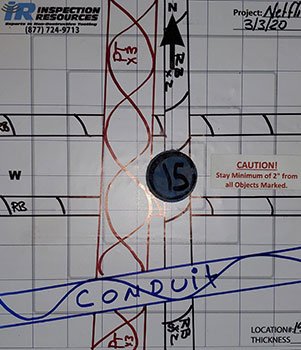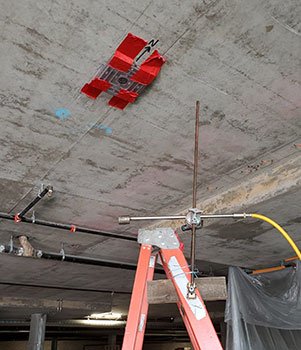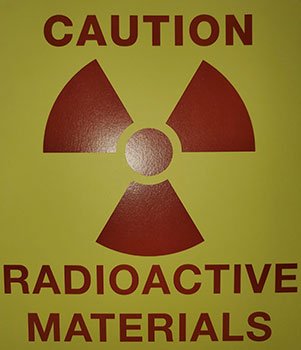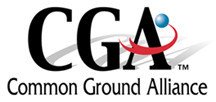Concrete X-Ray
Concrete X-Ray Los Angeles, Orange County by Inspection ResourcesWhen you need to know precisely what is located within your concrete structures, radiography (Concrete X-Ray) is the test method you need.
Inspection Resource’s concrete X-Ray service provides a greater level of detail about the size and type of material embedded within concrete decks, CMU, and concrete walls, especially in areas that are congested or contain overlapping systems.
The decision about which test method is best for a given situation depends on a variety of factors including objective, location, building use, and level of detail required. Inspection Resources client service representatives will discuss your specific concrete xray project requirements with you in advance so we can create a test solution that balances your need for detail with budget considerations and time constraints.
What is Concrete Radiography (Concrete Xray)?
Concrete radiography, also known as concrete X-ray, is a non-destructive testing (NDT) method used to inspect concrete structures. The process involves using a specialized X-ray machine that produces high-energy electromagnetic radiation to penetrate the concrete surface and create an image of the internal structure. This image can be used to identify any defects or abnormalities, such as Rebar, Post-Tension Cable, Plastic Conduits or voids, within the concrete.

Here are the basic steps involved in concrete radiography:
- Preparation: Before the radiography process begins, the area to be inspected must be cleared of any obstructions and properly marked. The radiograph machine and control equipment is set up in a safe location allowing approximately a 50’ distance from members of the general public..
- Calibration: Once the equipment is set up, a calculation process is performed to ensure proper exposure times given the thickness of concrete that is being tested.
- X-ray Imaging: With the equipment calibrated, the machine is directed at the concrete surface, and a high-energy beam of radiation is emitted. This beam passes through the concrete and hits a 14”x17” piece of film on the other side. The exposed film is processed onsite.
- Image Interpretation: The produced image is then analyzed by a trained technician to identify any objects or abnormalities within the concrete. The technician can also make measurements and determine the size of the abnormalities.
- Result Layout Directly on the Concrete: Our image interpretations are prepared onto a Target Sticker for clean and precise layout directly onto the test surface.
- Report Generation: Once the inspection is complete, a detailed digital report is generated detailing the findings. This report includes photographs of each shot location along with comments and recommendations to provide a clear and concise information for the project team.
Why is Concrete XRay Important?
Concrete X-ray, also known as concrete radiography, is an important non-destructive testing (NDT) technique used to inspect the internal structure of concrete. This type of concrete scanning is an important tool for professional engineers and contractors to inspect concrete structures, identify flaws or abnormalities, and ensure the safety and longevity of the structure.

Here are some reasons why concrete X-ray is important:
- Detect Internal Flaws: Concrete X-ray allows engineers and contractors to see the hidden internal structure of the concrete without causing any damage. This can help to detect any cracks, voids, embedded objects, or other flaws that may be present.
- Safety: Concrete X-ray is an important tool for ensuring the safety of structures. It can identify any potential structural weaknesses that could cause accidents or failures, and allow for timely repairs or preventative maintenance.
- Cost-Effective: Concrete X-ray can be a cost-effective solution for testing the structural integrity of old or aging concrete structures. It helps to identify defects early, so repairs can be made before they become more costly or extensive.
- Accuracy: Concrete X-ray can accurately determine the location, and size, of defects in concrete structures, which helps to facilitate prompt repairs.
- Compliance: Concrete X-ray is also helpful to ensure compliance with building codes and standards. It can identify any non-compliant portions of the concrete structure, allowing for corrective actions to be taken.
Concrete X-Ray vs GPR
Do not Confuse Concrete X-Ray with Ground Penetrating Radar (GPR). These are 2 separate technologies that are distinctly different in their use and expected results.
Concrete X-ray and Ground Penetrating Radar (GPR) are two non-destructive testing (NDT) techniques used to inspect the internal structure of concrete. While both methods can be useful for detecting flaws and abnormalities, there are some reasons why X-ray may be a better option than GPR in certain circumstances.

Here are some reasons why X-ray is a better option than GPR for concrete inspection:
- Precision: Concrete X-ray provides more precise images of the internal structure of the concrete.
- Imaging Quality: Concrete X-ray produces clearer and higher quality images compared to GPR, which can be affected by other objects or metal reinforcement in the concrete.
- Accuracy: Concrete X-ray can accurately determine the location, size, and positive identification of objects in concrete structures, which is very important when dealing with structures that contain both post-tension cables and rebar.
- Better for Plastic Conduit Detection: Bottom line is that Concrete X-ray can detect plastic conduits, or SMRF tubing. This has been proved countless times on our projects where clients have hit conduits after using GPR scanning.In conclusion, both concrete X-ray and GPR have unique characteristics that make them useful for different scenarios, but where precision and detail is required like high-stress areas such as bridge decks, high bay warehousing, parking structures, concrete x-ray may be the better option by providing clearer, high-quality images of the internal structure of the concrete.

Applying Methods
With both Ground Penetrating Radar and radiography test capabilities in-house, our concrete scanning specialists can identify subsurface elements in any application while keeping cost to a minimum.

Access Required
Both sides of the deck or wall must be accessible in order to use radiography. One side for the imaging film, and the other side for the emitting source.

Safety Is Key
Our concrete scan technicians are thoroughly trained and certified in radiation safety in accordance with state and federal guidelines. We make sure EVERY JOB is performed in a safe and professional manner.
Let’s work together! Inspection Resources is the premiere Concrete X-Ray and Ground Penetrating Radar Service provider in Southern California.
Your time is money. We are on site within 24 hours for more than 90% of our projects. Once testing is complete, we generate reports and distribute them digitally, often in near real time, getting the information to the people working on site as quickly as possible to avoid any delays.
Send us a message or call us today to discuss how we can help you.
Our Affiliates
We take Concrete X-Ray and Ground Penetrating Radar (GPR) services seriously. It’s not just our job, it’s out passion. We are a proud patner of the following industry organizations.
Benefits of Concrete X-Ray Services
While Concrete X-ray is an older form of technology, it’s extremely effective at providing clear imaging. X-ray is generally considered more precise than GPR scanning since there is less room for interpretation of the results. The Concrete X-ray is able to show more detail about the condition of embedded objects such as rebar and can even show areas of corrosion or other defects.
Concrete X-Ray vs. Ground Penetrating Radar
GPR is also an extremely effective method of determining what lies inside of concrete structures. Ground penetrating radar is non-destructive and can be used to quickly scan large areas with no prior set-up necessary. Access is only needed for one side of a slab or structure, and the radar can generally penetrate depths of 18-24”. GPR Services are comparatively lower in cost than other methods such as concrete x-ray imaging. Inspection Resources offers both Concrete X-Ray Service as well as GPR Service and can help you decide what the ideal method is for your needs.




